
Mar 31, 2001, The B. H. Manuscript/Collectible/Philatelic Sale, Sale 9

Lot 815
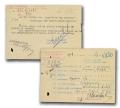

Arrest Papers. Lot
of two arrest papers filled out and signed. Both pieces are from the Vilna
Ghetto. 1. In German. One page, oblong duodecimo, Vilna, October 27, 1942.
Signed in blue crayon, with penciled notations. Stamped "Arrived" at bottom
left corner. There is some wear and two very small areas of paper loss at
the left edge but overall the piece is in very good
condition.
"Feitel, Simon is to be arrested and turned over to my
possession. The work-department is requested to send the above person
immediately to the work-camp Palemonas. Ghetto Police Chief."
2.
Partially printed, accomplished in manuscript. In German. One page, oblong
duodecimo, Vilna, October 1, 1942. Various ink notations. Three very small
areas of paper loss at the left, and overall this piece is in good
condition.
"From the Worker's Police. Michele Kowner, a worker in
the Energy plant. Grounds for arrest; non-appearance at work." In 1942, the
Vilna Ghetto was relatively quiet. After multiple mass Aktionen in 1941,
the Judenrat in Vilna worked to promote the policy of rescue through work,
believing that keeping the ghetto productive would ensure its survival -- a
hollow wish since the final liquidation of the Vilna Ghetto took place in
September of 1943.
Estimated Value $200-300.
Lot 816
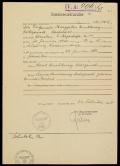

Auschwitz Death
Certificate. Partially printed, accomplished in manuscript. In German.
One page, small folio, Auschwitz, February 23, 1942. Stamped twice and
signed by the Registry Office, Auschwitz. One faint horizontal and one
faint vertical crease. Overall condition is very good.
Mieczyslaw
Deurbbrowicz Dobrzanski, registered as a "Zugenieur" or gypsy, died January
11, 1942, two weeks before his 60th birthday. An example of the death
certificates sent to the families primarily of people who died in the labor
camps at Auschwitz. A disturbing record from a place where death was an
inescapable part of daily existence.
Estimated Value $150-250.
Lot 817


Auschwitz Pramienschein
1RM. Note printed on heavy red stock. Round camp overstamp reads
"Waffen SS Komandantur K.L. Auschwitz" and there is a faint Reich eagle in
the center. "Pramienschein über RM. 1- / Konzentrationslager
Auschwitz" printed at top, printer's number at bottom reads "KL/101 - 8.
44/500.000." Rare issue in very good to fine condition.
Auschwitz
was one of the few camps that issued its own script. The "8.44" in the
printer's mark would seem to indicate an August 1944 print date, five
months before Auschwitz was liberated.
Estimated Value $250-450.
Lot 818


Bohemia and Moravia.
Lot of two items, remnants of Nazi oppression in their "Protectorate of
Bohemia and Moravia." 1. To Herr Karl Gottlieb, notification to all Jewish
owners of bicycles and typewriters that they must register possession of
these items on the specified forms, without delay. In German and Czech. One
page, small quarto, Brünn (Brno), September 4, 1941. Printed document.
Some edge separation at vertical crease, faint creases and a very small
tear at the bottom right corner, minor adhesive residue at name and stamps
indicating place and dates, but overall condition is good. 2. Printed milk
ration card with Star of David stamp. Issue 53, valid from August
23-September 19, 1943. In German and Czech. One page, small quarto, August
1943. Chits have been clipped away at right. Condition is very good.
By summer of 1943, all Czechs designated "Voll Juden" ("Full Jews")
had been deported. The remaining Jews were members of the Jewish Council
(and their families) and partners in Christian/Jewish marriages. The second
piece offered here must have belonged to one of these individuals, most of
whom were deported to Theresienstadt in early 1945.
Estimated Value
$150-200.
Lot 819


Buchenwald Doctor's
Bill. Partially printed, accomplished in typescript. In German. Being a
receipt from Oscar Rothacker Medical Bookstore, Berlin, for prescription
pads. Two holes punched at left, two very small areas of paper loss also at
left. Signature and received stamp on verso. One vertical fold, in very
good condition.
This bill for prescription pads was sent to
Buchenwald Concentration Camp to the SS doctor in charge -- "Der
Lagerarzt," a Hauptsturmführer whose signature is unfortunately
unreadable. The medical tortures at Buchenwald are notorious and included
large-scale experiments involving the infecting inmates with typhus.
Estimated Value $100-150.
Lot 820


Censored Postcards.
Stamped "In hebräischer und jiddischer Sprache verboten" in purple
ink, with the objectionable passages marked in red, these two postcards
ended up in the censor's dead-letter pile. In the midst of tragedy and
hatred, these hijacked missives speak of deep love and concern.
1.
In German and Yiddish. Two pages, oblong duodecimo, Lodz, date illegible.
In black ink on a pre-printed six pfennig postcard. To Dawid Szlit. There
are two penciled notations and the censor's stamp, but otherwise this
document is in very good condition.
On the recto Udel Szlit writes
to her son in a Nazi forced labor camp, "I kiss you. My only goal is to
see you." On the recto her daughter Esther writes, "I received your
postcard, which made me very happy. I am very weak and am lying in bed. I
wanted to send you socks and underwear, but it is not permitted..." The
Lodz/Names project lists Abram Jankiel, Ester, Mojsze Hersz, Nuchem Dawid,
Rachel and Udel Szlit at address Kurze 5/7 in the Lodz Ghetto. Abram
Jankiel, Mojsze Hersz, Nuchem Dawid and Rachel were deported, as was Ester.
Udel Szlit died March 24, 1942, one month after Ester's
deportation.
2. In German and Yiddish. Two pages, oblong duodecimo,
Lodz, November 18, 1941. In black ink on a pre-printed six pfennig
postcard. To A. Winograd. The censor's marks and stamp are visible. This
piece is in very good condition.
From Nachman Kuperwasser to A.
Winograd. "...You can't imagine the joy we had at receiving your
letters...We are (thank God) all healthy...Our beloved Father sends
greetings..." On the verso, "We were happy to receive the money.
Simsia (?) was without shoes and I bought him some today."
In
the Lodz/Names project, Nachman, Cyrla and Szymon Kuperwasser are listed at
Sulzfelder Strasse 66.
Estimated Value $150-200.
Lot 821
Concentration Camp
Photographs. Five black and white photographs, 4½ x 2¾".
Some toning and foxing. Overall condition good to very
good.
Dramatic photographs of the aftermath of the German policy of
genocide, four of the photographs are of human remains and one picture is
of ovens.
Estimated Value $100-UP.
Lot 822


Concentration Camp
Registration Forms. Lot of three blank registration forms. The
questions include basic identity queries, but also ask for party
affiliation, position in the party and if there have been any previous
political or criminal arrests. Three different formats, but all serve the
purpose of recording the flow of humanity through the gates the camps. 1.
Large format form, including an area for a signature from the prison
commander. The form number is KL/42/8.44 200.000. In German. Two pages,
small folio, n.p., n.d. There is one small indentation in the paper, but
otherwise this piece is in very fine condition. 2.
"Häftlings-Personal-Karte" form number KL./5/9.44 500.000. In German.
Two pages, small quarto, n.p., n.d. There is a very small crease in the
upper right corner, but otherwise this piece is in very fine condition. 3.
Form number is KL. 25/3.44 100.000. In German. Two pages, small quarto,
n.p., n.d. On manila card stock. Includes a place for a photo, immediately
adjacent is a spot for "Deceased On." There is a very faint crease at the
top right corner but otherwise this piece is in very fine condition.
Estimated Value $150-250.
Lot 823


Financial Bureaucracy
of Ghetto Administration. Here we offer three examples of the nuts and
bolts of keeping the finances of a ghetto running. Including: 1. Request
for full payment of wages. In German. Two pages, oblong duodecimo,
Kreuzsee, November 23, 1941. In blue ink on a pre-printed six pfennig
stamp. To the" Aeltesten der Juden" in Litzmannstadt (Lodz). There are two
small holes punched at the left edge that have been torn though, a bit of
soiling, and some ink has run, but otherwise this piece is in good
condition.
Stamped received in Lodz on the 27th, there are several
pen and pencil notations recto and verso indicating the request had been
read. "I work for R.A.B. (a forced labor camp) in Kreuzsee and am
writing to find out why my aunt R. Frankenstejn...receives only 24 RM. I am
asking kindly to pay my aunt 48 RM monthly for which I offer thanks in
advance. Hoping that my request will be fulfilled, with friendly greeting,
J. Grinsztajin."
2. Receipt requested postcard. In German. One
page, oblong duodecimo, Prague, May 11, 1942. Typed on a pre-printed 60
haleru postcard, signed Otto Stein. To the Gettoverwaltung in Lodz. There
is light soiling at the edges and a bit of fraying at the top, but this
piece is in very good condition.
Mailed through the Office of the
Jewish Council of the Ghetto in Prague. Stamps and pencil marks indicate
the request was received on May 15, 1942. "I am sending...Otto
Grüner...RM 20 and ask that the above gentleman sign a reply card to
verify receipt. Respectfully, Otto Stein."
3. Partially printed
receipt for 50 RM, accomplished in manuscript on a postcard with a three
pfennig stamp. In German. Two pages, oblong duodecimo, Lodz, December 7,
1943. To Dr. Richard Poll(?)k. There is light soiling and the postmark has
bled through somewhat, but this piece is in good condition.
Mailed
from Lodz to Prague, the postmark includes "Litzmannstadt grösste
Textil-Industrie Im Osten."
Estimated Value $150-250.
Lot 824
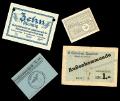

German Concentration
Camp Notes. Total of four pieces from camps on German soil: 10 pfennig
note from Oranienburg, Flossenbürg 1 RM.01 RM from Mittelbau and
Buchenwald Aussenkommando 1 RM. Oranienburg note has one punched hole at
right and one punched hole at left edge, "Lagergeld des
konzentrationslagers Oranienburg" recto and facsimile signature of the
Standarten-- and Kassen-- führers and Lagerkommandant on the verso.
Prämienschein from Flossenbürg shows some fading at edges, has
overstamp "Waffen SS Verwaltung Konzentrationslager Flossenbürg" and
printer's mark "KL/101 - 11.44/1.000.000." Buchenwald note has
"Aussenkommando" designation, "SS-Arbeitskommando A 6" stamped on note and
serial number 68387, this note shows wear and there is some edge and fold
separation at the horizontal crease. "Arbeitslager Mittelbau serie N" note
is serial number 03335 (printed on verso) and shows some age toning.
Conditions range from very good to fair.
Oranienburg was only in
operation from 1933 to 1935, but it quickly gained reputation for
brutality. Its initial population consisted mostly of communists and social
democrats and it remained a prison for "enemies of the people." Buchenwald
was established in July 1937 and continued operation, expanding into
satellite work camps, until April of 1945 -- "Aussenkommando" notes were
issued to pay for work in Buchenwald's several hundred auxiliaries.
Mittlebau, a sub-camp of Buchenwald, housed thousands working on tunnels
for a V-2 and munitions plant. Konzentrationslager Flossenbürg was
active from May 1938 until April 1945 and housed anywhere from 5,000 to
18,000 prisoners at any one time -- most of whom worked in a local quarries
or armament factories.
Estimated Value $150-UP.
Lot 825
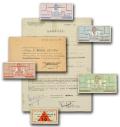

Jews in the
Netherlands. Lot of three items relating to the status of Jews in the
Netherlands including: 1. Permission slip for post-curfew travel. Partially
printed, accomplished in manuscript. In Dutch. One page, small quarto,
Amsterdam, August 17, 1943. One horizontal and one vertical crease and
foxing, but the overall condition of this piece is good.
Among the
many regulations the Joodse Raad (Jewish Council) of Amsterdam was
responsible for enforcing was a strict curfew and special permission was
required to travel after dark. The piece offered in this lot appears to be
a standard permission slip for being abroad after curfew, but a more
troubling question arises given the date. By August of 1943, most of the
Jews of Amsterdam had been deported, with less than 2000 remaining;
primarily members of the Joodse Raad, their senior staff and families. The
pass may have been written to establish E. Blueth's importance as one of
these individuals and thus ensure safety. This would have been a futile
effort, as on September 29, most of the remaining Jews in Amsterdam were
taken to the Westerbork transit camp and, from there, most were sent to
Auschwitz.
2. Incomplete set of paper currency from "Lager
Westerbork / 15 Februar 1944;" 10 cent, 25 cent, 50 cent and 100 cent. Also
a 10 cent Gutschein from Amersfoort prison camp, date of issue January 1,
1944; "Häftlings-Kantinegeld." Some very light edge discoloration on
two of the pieces, but the overall condition is very
good.
Originally built by the Dutch government to house Jews fleeing
Hitler's Germany, the Nazi invasion of 1940 meant that by 1942, Westerbork
became a transit camp for Eastern deportations. Amersfoort, pre-war, served
as a penal camp. During the war it continued in that function but was also
used to confine and deport the local Jewish population to Poland. Following
Germany's defeat, Westerbork served as a displaced persons camp.
3.
An official "Verklaring" (Declaration): travel papers for Freiderike
Blueth-Henschel, for return to Amsterdam. Partially printed, accomplished
in typescript. In Dutch and English. One page, quarto, Westerbork camp,
June 8, 1945. On vertical and three horizontal creases with some edge
separation. There are two diagonal creases at the top right corner. Two
holes have been punched in the left edge and some tape repairs have been
made. There is some minor foxing and this piece is in fair to good
condition.
"All authorities are requested to lend the necessary
assistance to above-mentioned to reach his new residence. / This
certificate is also valid as a permit to travel on the day of issue."
Estimated Value $200-300.
Lot 826


Lodz Collection I.
Lot of five. A collection of paper ephemera that illustrates day-to-day
life and administration in the Lodz Ghetto. 1. Notification of release of
Victor Sztajn. In German. One page, 3 x 8½, Lodz, February 13, 1944.
Typed note. Stamped once in purple by the office of "Der Aeltesten der
Juden in Litzmannstadt." There are a few horizontal creases and some age
toning at the edges. Overall condition is very good. 2. Receipt for posting
15 RM from Lodz to Dachau. Partially printed, accomplished in manuscript.
In German. One page, duodecimo, Lodz, March 14, 1942. One "Litzmannstadt"
postmark. In very good condition. 3. Letter regarding banking transactions.
Partially typed, accomplished in manuscript. In German. One page, quarto,
Lodz, July 19, 1941. On Der Oberbürgermeister von Litzmannstadt
letterhead. To the Aelteste der Juden. There are several notations and
stamps; one of the stamps indicates a new address for the
Oberbürgermeister at the Getto Verwaltung. There is minor edge
creasing and some age toning at the edges, but the overall condition is
very good. 4. Reciept for a postal order of 20 RM. In German. One page,
small quarto, Lodz, July 18, 1941. Typed on lined paper, the verso was a
ledger page and writing is present. There is a small stain at the right
edge, as well as some discoloration, one horizontal and one vertical
crease. Condition is good. 5. Recipt for payment of toll on goods.
Partially printed, accomplished in manuscript. In German. One page, quarto,
Lodz, October 27, 1941. Some age toning. several stamps and notations
across the face of the document, minor crumpling at the top left and right
corners, five small staple holes and some adhesive residue at the right of
the document. Several official stamps. Overall condition is good.
Estimated Value $200-250.
Lot 827
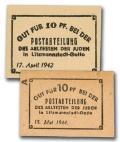

Lodz Collection II.
Lot of five. More paper ephemera that brings home the tangled
bureaucracy and regulations that governed life in the Ghetto.1. Post Office
Chit for 10 pfennigs. Issue date April 17, 1942. Some minor age toning, in
fine condition. 2. Post Office Chit for 10 pfennigs. Issue date May 15,
1944. Some minor age toning, in fine condition. (In April 1942 and May 1944
there was a shortage of small change in the Lodz Ghetto and the Post Office
was ordered to issue these chits. Because raw materials were scarce, the
chits were printed on any paper or card stock that happened to be at hand,
hence the variety of chits found.) 3. Receipt for packet of necessities
received by C. Weinstock and family. Partially printed, accomplished in
manuscript. In German. One page, small quarto, Lodz, November 3, 1941.
Assorted notations and stamps. There is some minor fraying at the edges,
two staple stains, ten very small staple holes, one vertical and one
horizontal crease. Overall condition is good. (While the specific items are
not named, the package received had items suitable for a family of three,
ages 1½ to 38 years. By the end of 1941, the bureaucracy of the
Aeltestenrat was firmly established and the distribution of Nazi issued
foodstuffs was in the hands of Rumkowski's administration. Given conditions
in the ghetto, it is certain that any goods Family Weinstock received were
insufficient in meeting even minimal nutritional requirements.) 4. Receipt
for Rachel Weissman. Partially printed, accomplished in typescript. In
German. One page, duodecimo, January 1, 1944. There is some soiling and
minor fraying at the right edge. There are intact perforations at the left
edge. 5. Work assignment from the Arbeitsamt. Partially printed,
accomplished in manuscript. In German. One page, 8 x 3," Lodz, January 1,
1943. Blue slip of paper with work assignment, stamped and signed by the
Arbeitsamt of the Judenrat. Horizontal and vertical folds, some aging of
paper. In good condition. (By 1943, almost the only people left in the
Ghetto were those fit for work; while liquidations continued and conditions
worsened, the factories ran on.).
Estimated Value $200-250.
Lot 828


Lodz Currency. An
interesting lot of seven. Five Quittung Notes from the Lodz Ghetto and two
Lodz rubles (one from 1915 and one from 1916). The Ghetto notes are in 50
pfennig, 1, 2, 5, and 20 mark denominations, all issued May 15, 1940. The 2
and 5 mark notes show wear and there has been a tape repair made on the 2
mark piece. The 5 rubles note (1915) shows some wear and there is minor
edge separation at the top. The 1 ruble note (1916) shows some soiling and
edge wear. Conditions range from good to fine.
The WWI era currency
(printed in Polish and Russian) shows how important the Jews in Lodz were
in all aspects of life -- five of the six officials listed have Jewish
names and this is an interesting addition to the lot of Quitting notes.
Called "Rumkies," after Rumkowski (whose signature appears on the notes),
the Ghetto currency was issued in order to curb smuggling. Jews were
required to exchange their marks and zlotys for these notes, which were
worthless outside the Ghetto and of no use to smugglers -- yet another
means of social control.
Estimated Value $100-150.
Lot 829
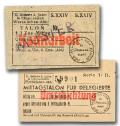

Lodz Ghetto Script.
Lot of fifteen pieces of Lodz script in various types and from several
different issuers. Script was used to purchase coal, food and clothing.
This collection includes notes for coal, socks, potatoes and lunch, among
other things. A few of the notes are overprinted with "Muster," meaning
specimen. Various sizes and conditions range from very good to fine.
Estimated Value $150-250.
Lot 830
Lodz Ladle. Nickled
brass ladle. 9" long, bowl is 1½" deep. Front of ladle is stamped
"W. Rydza," reverse is stamped "M. Lider" and "Lodz" with a Star of David
between the two. Finish wear on handle and some pitting in bowl. Condition
is very good.
The stamp on the front of the ladle, "W. Rydza," is
presumably the maker, but may be an owner. The stamp on the reverse, "M.
Lider," refers to Mordka Lider, born 1872. Listed in the Lodz/Names project
as a "Kaufmann" (businessman or merchant), his ghetto address is listed as
6 Bleicher (Ciesielska in Polish), where he lived with Bluma, born in 1880
and Rywka, born in 1912. Mordka and Bluma Lider are listed "GEST"
(gestorben) August 23, 1942.
Estimated Value $150-UP.
Lot 831


Lublin Clogs. Pair
of clogs, size 42, manufactured at the forced labor factories in Lublin.
Leather nailed to painted wooden soles, interior stamped "Deutsche
Ausrüstungswerke, Gmbh, Lublin." The clogs have never been worn. Fine
condition.
Nazi authorities in Lublin (primarily the SS) operated
the largest forced labor shoe factory in occupied Europe. Originally opened
to utilize Jewish POWs, by 1940 the Nazis were demanding civilians be
turned over for use in the factories. When the Judenrat failed to produce
enough names, individual Jews were seized from ghetto streets. Prisoners
disassembled leather goods confiscated from Jews all over Europe, including
shoes, briefcases and suitcases (over 49,000 items were received in October
1943 alone) and nailed them to wooden soles produced at local forced labor
sawmills. Records list 337,259 pairs of completed clogs in the Lublin
warehouse at the beginning of November 1943. On November 3, 1943, as part
of the Erntefest Aktion, 42,000 Jews in the Lublin district were
rounded up and shot, including most of the Jews working in the factories.
Estimated Value $250-UP.
Lot 832


Nowy Sacz. Lot of
two documents, including: 1. Apartment assignment for Mrs. Hollander (?).
Partially printed, accomplished in manuscript. In Polish. One page, small
quarto, Nowy Sacz (Neu Sandoz), April 16, 1941. There is some paper loss at
the left edge, a vertical crease and horizontal crease and some foxing and
fading. Overall this piece is in good condition.
Based on an order
that was issued by the Commissioner of the City, issued in December 1940,
"The people who have been assigned must be moved in to the assigned
place by the Jewish Police." Stamped "Judischer Ordungsdienst Neu
Sandoz."
2. Application for housing. Partially printed, accomplished
in manuscript. In German. One page, folio, Nowy Sacz, May 23, 1941. There
is some creasing, folding and four very small tears at the top edge, water
stains at the bottom edge. Overall, condition is good.
The
applicant, Chiel Buchsbaum, has been transported with his family to Nowy
Sacz and requests permission to take an apartment. The request is to the
City Office, through the Jewish Council, because the ghetto at Nowy Sacz
was not formalized until August of 1941. Any living arrangements would have
been very temporary; in mid-August of 1942 the entire ghetto was
transported to the Belzec death camp and killed.
Estimated Value
$150-200.
Lot 833
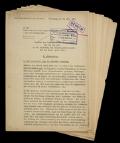

Official May 12, 1941
Nazi Document. Typed Document. In German. Nineteen pages, quarto,
Warsaw, May 12, 1941. Being a report from District Chiefs in Warsaw to the
Generalgouvernment for the month of April 1941. Two stamps on first page,
including "Geheim" ["Secret"]. Filing holes at left, edge
wear on first page, one horizontal fold with edge separation throughout
document. Fair to good condition.
The Nazi bureaucracy churned out
continual reports, combining the mundane details of administration with
chilling matter-of-fact recitations of the organized ghettoization and
exploitation of Jews and other "undesirables." The unique document offered
here and originally intended for Party eyes only, finds the Nazis firmly
established in Poland with their instruments of murder and oppression in
place and offers evidence of their plans to invade the Soviet Union.
"...The entire population is quiet. Only in the East has the population
begun to prepare for evacuation in case of war...While the Jews are on the
side of the Soviet Union, the sympathies of the Poles are divided..." The
document continues with financial accounts regarding rents, coal, factory
production and the like -- a primary concern is the acquisition and
distribution of food: "...In addition to the afore-mentioned groups
requiring food supplies the Jewish barracks, where 25,000 Jews will be
housed, must be taken into account in our supply plan." Regarding forced
labor, "...In the month of April, work began on the waterworks. For the
planned labor camps, something like 5000 Jews can be provided by the labor
office. The work of the Jews is at present completely insufficient, which
is due to the initial difficulties encountered." And more, "...In the case
of the medical examination of the drafted Jews, the result was that
something like 40% are regarded as unfit for work. All Jews in the Jewish
residential area are at present being examined, by age group. Those Jews
found unfit by Polish physicians are re-examined by German physicians...For
the large projects outside of the ghetto, altogether 27,000 jobs remain.
Although it has been pointed out to the Jews that this is not heavy labor,
but involves light work, they have been responding to calls for workers in
small numbers. This is mainly due to the earlier camp conditions in the
Lublin Distrikt. Therefore all that remains is a forcible demonstration for
the required Jews." Our document (it probably lacks the final few pages)
ends with an account of public health conditions in Warsaw and Lublin,
including the growing incidence of typhus.
Estimated Value $250-UP.
Lot 834
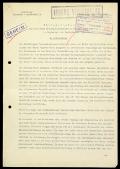

Official October 8,
1940 Nazi Document. Typed Document. In German. Fourteen pages, quarto,
Warsaw, October 8, 1940. Being a report on the economic status of the
"purification" of the Warsaw economy issued by the Department of Trust --
Branch Office. Stamped three times on the first page, including
"Geheim" ["Secret"] and initialed on last page. Filing holes
at left, staples holes at top left corner, minor soiling on first page and
one horizontal fold. Very good condition.
The systematic seizure of
Jewish and Polish owned property and businesses was an integral part of the
Nazi scheme when they invaded Warsaw in late 1939 and the report offered
here, covering the details of September 1940, offers concrete documentation
of their success after less than a year of control. The increasing pressure
on Warsaw's Jews is illustrated vividly in this report -- in September the
number of confiscated properties jumped from 2844 to 4391 and according to
the report: "...The first consequence of this increase is the increased
suppression of the Jewish influence on residential and real estate property
and the damming up of its harmful effects on the entire economy." The
report goes on to offer figures on rents in arrears, the value of seized
bank accounts and monies gained from seized properties. Other measures are
reported on, in particular the closure of printing houses except those
under Nazi control and two operating exclusively for the Jewish Council.
Concern is raised that the measures being taken are not profitable enough
and one of the reasons offered is: "...it is almost certain that important
goods and net assets are still in the hands of Jews...The camouflage of
Jewish fortunes is a popular means of avoiding reporting regulations and
they are helped in their dirty business by Polish and ethnic German
henchmen..." Also noted: "...In the reported month, there were also
extensive seizures of economic and factory goods. Notably wood and
sawmills, almost exclusively owned by Jews, as well as a number of other
machines, were seized." In less than two months, the Nazis would force all
of Warsaw's Jews into the newly established Ghetto and take over all
remaining Jewish property outside the Ghetto.
Estimated Value $250-UP.
Lot 835
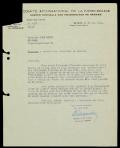

Outside assistance.
Lot of three documents. As conditions worsened across Europe, Jewish
organizations and individuals sought assistance from the world at large. In
many instances, the help was too little, too late. 1. In French. On page,
large quarto, May 25, 1944. On International Committee of the Red Cross /
Central Agency of War Prisoners letterhead. To Monsieur Saly Mayer. One
horizontal and one vertical crease. Three file holes at the left edge and
paper loss (presumably the Red Cross insignia) at upper left corner.
Overall condition is very good.
Regarding "Aid to the Israelites in
Croatia." Acknowledging receipt of Monsieur Mayer's letter and referring to
a conversation in Geneva. "...we took our delegation to Zagreb to put
ourselves in contact with the "Jewish Community" of this city in order for
it to be part of your desire to receive pieces of
information...
2. In German. One page, octavo, Sosnowitz, "6.
lutego," 1942. On "Der Leiter / Der Aeltestenräte der Jüdischen
Kultusgemeinden / In Ost Oberschlesien" letterhead. To Alfred Szwarcbaum in
Lausanne. Blue office stamp and signature of Fanny Sara Czarna from the
office of the Aeltestenräte. One vertical stamp and soft creases at
bottom edges, some minor paper loss, a few notations, condition is very
good.
"Enclosed we present a list, in duplicate, of the care
packages received thus far. We are eager to express our thanks for your
efforts and helpfulness and eagerly await your further reply."
3. In German. One page, oblong octavo, Warsaw, November 11,
1941. On a preprinted Generalgouvernement postcard. In black ink. To the
"Komitee zur Hilfeleistung fur die Kriegsbetroffene judische
Bevölkerung" in Genf. There is some age toning, but the overall
condition is very good.
Several postmarks and a red censor's pencil
are noted on this piece. From an unhappy M. Goldfarb; "...the contents
of the packages were essentially inferior and hardly covers the receipt
expenses. Please arrange with your sender in Lisbon to send only roasted
coffee beans, that is what I require on health grounds."
Estimated
Value $200-250.
Lot 836
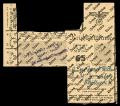

Ration Cards. Lot
of three very interesting ration cards. 1. Partially printed, accomplished
in manuscript. In German. One page, octavo, Wiesbaden, July 7, 1944.
"Grease Card," stamped repeatedly "Juden" and stamped with the name of the
grocer. Valid July 24 - August 20, 1944. Most sections have been clipped.
In very good condition.
Deportation of Wiesbaden's "Voll Juden"
("Full Jews") population began in early 1942 and by the end of 1942 only
three Jewish families remained in the city. The late date on this card and
the Jewish designation indicates either a partner in a mixed marriage or a
very highly protected individual. The ration card is made out to Gunther
Israel Kahn.
2. Partially printed, accomplished in manuscript. In
Hungarian. One page, duodecimo, Budapest, November 1944. Ration card for
grease, several of the chits have been cut away. Minor crumpling and aging,
in good condition. 3. Partially printed, accomplished in manuscript. In
Hungarian. One page, duodecimo, November 1944. Ration card for sugar,
includes serial number, several of the chits have been cut away. Minor
crumpling and aging, in good condition.
Both of these cards, valid
for November 1944, have been used. With German occupation in March 1944,
conditions for the over 200,000 Jews in Budapest (which included large
populations of refugees from Austria, Poland and Slovakia) deteriorated
rapidly as deportations and anti-Jewish measures began. There was a short
pause in deportations during the summer months, but they began again in
earnest on November 8 and a ghetto was established on November 13. When
Budapest was taken by the Soviets in early 1945, there were 120,000 Jews
left in the city.
Estimated Value $150-200.
Lot 837
Riga Ghetto Identity
Card. In German. Two pages, recto, small octavo, Riga Ghetto, n.d.
Handwritten and printed in black ink on heavy stock. An identity card for
the Central Work Station in the Riga Ghetto which has not been filled out.
Heavy soiling and staining, tape strengthening, small hole on first page.
Poor condition.
Most of the Jews in Riga who could not work were
killed in short order. The remaining Jews were put into forced labor until
they became too weak or ill to work and continuing actions by the Nazis and
their Latvian sympathizers resulted in more and more murders and
deportations. By December of 1943 the Riga Ghetto had been cleared of its
occupants.
Estimated Value $50-UP.
Lot 838
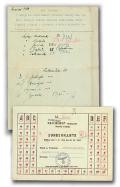

Sonderkarte. In
German and Polish. Two pages, small quarto, Rzeszów, Poland,
1941-1942. Recto is printed document with notations, verso is typed and
handwritten note. One vertical crease with some soiling, some very minor
crumpling at bottom. Overall condition is good to very good.
A
unique document which illustrates the progression of Nazi persecution in
Eastern Europe, as they moved through the ranks of Jews, Gypsies and other
"undesirables" into the ranks of the intelligentsia. The recto is a ration
card for the Judenrat of Rzeszów (the Germans renamed it Reichshof),
good from October 1, 1941 to April 30, 1942. There are a couple notations
and the stamp of the Nazi office in charge of the district. The verso
points in the next step in Nazi domination, taken after they had the
"Jewish Question" in hand. The document, in Polish, was written in
September of 1944, by which point all of the Jews in Rzeszów had
either been killed or deported. The text reads, "Due to a strong necessity
for help for the wives of the Fully Titled friends, who were taken by
Germans, we are asking for a bigger contribution, if possible." Then
follows a handwritten list of Polish judges and prosecutors with monetary
amounts in zlotys or the word "no." This was probably written for the
purpose of raising contributions for the wives of fellow lawyers (the
"Fully Titled") who had been arrested by the Germans.
Estimated Value
$150-250.
Lot 839
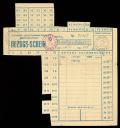

Theresienstadt
Paperwork. Lot of two items illustrating the paperwork that governed
daily life at Theresienstadt. 1. Arbeitsausweis for Rudolf Bienenfeld. The
work identification papers were to be placed in the personal identification
booklet and listed Bienenfeld's assigned work. Partially printed,
accomplished in manuscript. In German. Six pages, octavo, March 16, 1945,
Theresienstadt. Some soiling and minor creasing at the edges, but this
piece is in good condition. 2. Bezugs-Schein. Primarily printed,
accomplished in manuscript. In German. One page, formerly large quarto,
n.d., Theresienstadt. Made out for Artur Lustig to use in Theresienstadt,
issued by the Jewish Selbstverwaltung. Sections clipped out for use. One
vertical and one horizontal crease. This piece is in good condition.
Estimated Value $150-200.